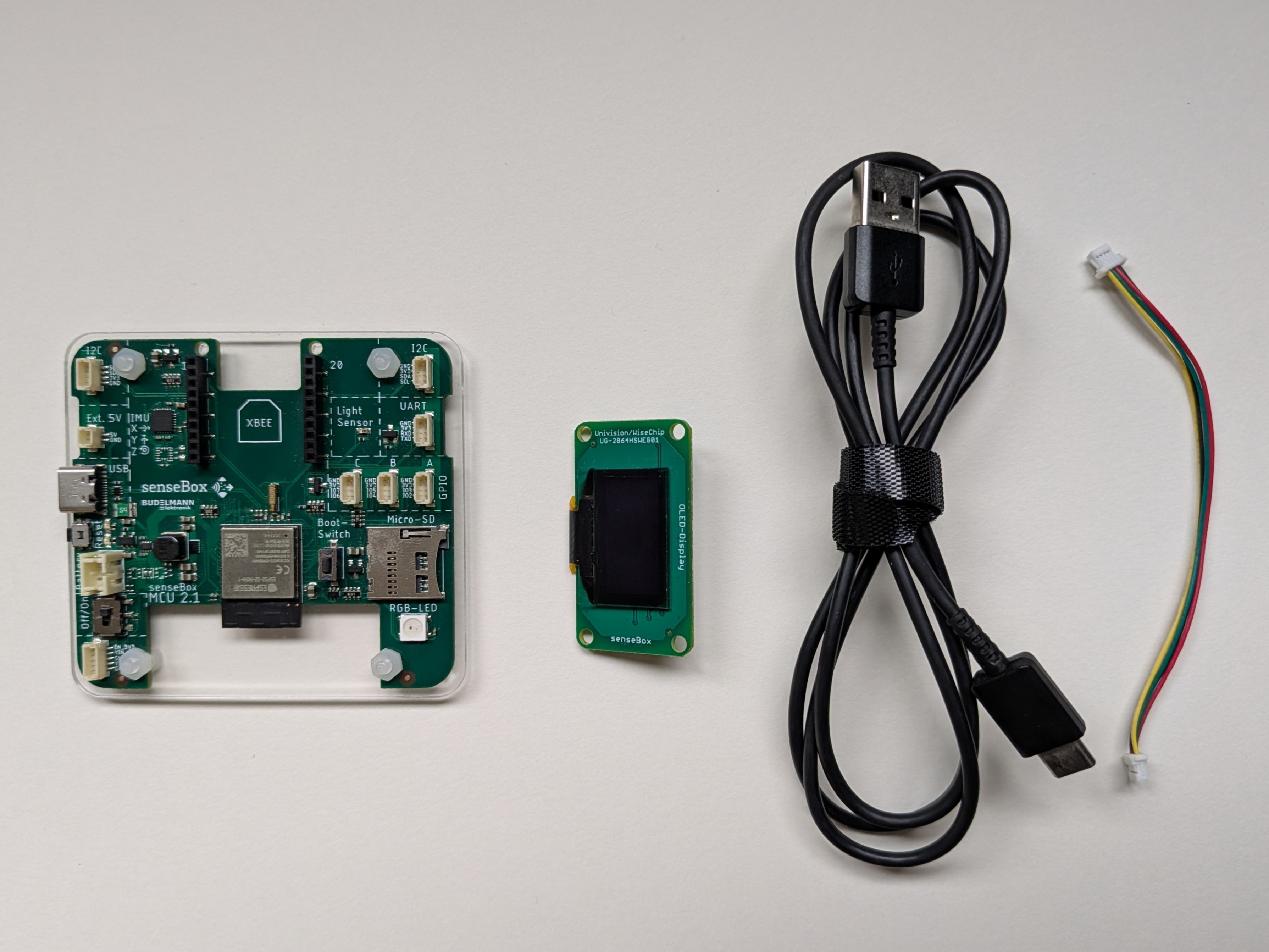CircuitPython Beispiel: Brick Breaker
In diesem Beispiel zeigen wir dir, wie du ein einfaches Brick Breaker Spiel mit CircuitPython auf der senseBox MCU-S2 erstellen kannst. Das Spiel nutzt den integrierten Gyroskop-Sensor zur Steuerung und das OLED Display zur Anzeige.

Brick Breaker auf der senseBox MCU-S2
Eine ausführliche Anleitung mit Schritt-für-Schritt Erklärungen findest du auf der Projekt-Seite.
Benötigte Bibliotheken

Setup für das Brick Breaker Spiel
Spielsteuerung
Das Spiel wird mit dem Gyroskop-Sensor der senseBox MCU-S2 gesteuert. Schüttel die senseBox, um das Spiel zu starten. Kippe die senseBox nach links oder rechts, um den Schläger zu bewegen und die Blöcke zu treffen. Du hast das Spiel verloren, wenn der Ball den unteren Rand des Displays berührt. Schüttel die senseBox erneut, um das Spiel zurückzusetzen. Das Spiel ist gewonnen, wenn alle Blöcke zerstört wurden.

Gyroskop Steuerung
Code
import time
import board
import displayio
import digitalio
import busio
import microcontroller
from i2cdisplaybus import I2CDisplayBus
import adafruit_displayio_ssd1306
import adafruit_mpu6050
import math
# Enable IO power
io_enable_pin = digitalio.DigitalInOut(board.IO_POWER)
io_enable_pin.direction = digitalio.Direction.OUTPUT
io_enable_pin.value = False
time.sleep(0.5)
# Initialize display
displayio.release_displays()
i2c_display = board.I2C()
display_bus = I2CDisplayBus(i2c_display, device_address=0x3D)
display = adafruit_displayio_ssd1306.SSD1306(display_bus, width=128, height=64)
# Initialize MPU6050
scl = microcontroller.pin.GPIO42
sda = microcontroller.pin.GPIO45
i2c_mpu = busio.I2C(scl, sda)
mpu = adafruit_mpu6050.MPU6050(i2c_mpu)
# Game constants
PADDLE_WIDTH = 20
PADDLE_HEIGHT = 3
PADDLE_Y = 58
PADDLE_SPEED = 2.0
BALL_SIZE = 2
BALL_SPEED = 1.5
BRICK_WIDTH = 12
BRICK_HEIGHT = 4
BRICK_ROWS = 3
BRICK_COLS = 10
BRICK_SPACING = 1
# Game state
paddle_x = 54 # Center position
ball_x = 64.0
ball_y = 50.0
ball_dx = 0.0
ball_dy = 0.0
game_started = False
game_over = False
game_won = False
# Bricks array (True = exists, False = destroyed)
bricks = [[True for _ in range(BRICK_COLS)] for _ in range(BRICK_ROWS)]
def create_display():
"""Create initial display with bricks and paddle"""
group = displayio.Group()
# Background
bg_bitmap = displayio.Bitmap(128, 64, 1)
bg_palette = displayio.Palette(1)
bg_palette[0] = 0x000000
bg_sprite = displayio.TileGrid(bg_bitmap, pixel_shader=bg_palette)
group.append(bg_sprite)
# Draw bricks
brick_palette = displayio.Palette(1)
brick_palette[0] = 0xFFFFFF
for row in range(BRICK_ROWS):
for col in range(BRICK_COLS):
if bricks[row][col]:
x = col * (BRICK_WIDTH + BRICK_SPACING) + 4
y = row * (BRICK_HEIGHT + BRICK_SPACING) + 4
brick_bitmap = displayio.Bitmap(BRICK_WIDTH, BRICK_HEIGHT, 1)
brick_sprite = displayio.TileGrid(
brick_bitmap,
pixel_shader=brick_palette,
x=x,
y=y
)
group.append(brick_sprite)
return group
def draw_paddle(group, x):
"""Draw paddle at position"""
paddle_palette = displayio.Palette(1)
paddle_palette[0] = 0xFFFFFF
paddle_bitmap = displayio.Bitmap(PADDLE_WIDTH, PADDLE_HEIGHT, 1)
paddle_sprite = displayio.TileGrid(
paddle_bitmap,
pixel_shader=paddle_palette,
x=int(x),
y=PADDLE_Y
)
group.append(paddle_sprite)
return paddle_sprite
def draw_ball(group, x, y):
"""Draw ball at position"""
ball_palette = displayio.Palette(1)
ball_palette[0] = 0xFFFFFF
ball_bitmap = displayio.Bitmap(BALL_SIZE, BALL_SIZE, 1)
ball_sprite = displayio.TileGrid(
ball_bitmap,
pixel_shader=ball_palette,
x=int(x),
y=int(y)
)
group.append(ball_sprite)
return ball_sprite
def check_brick_collision(x, y):
"""Check if ball hits a brick and remove it"""
global bricks
for row in range(BRICK_ROWS):
for col in range(BRICK_COLS):
if bricks[row][col]:
brick_x = col * (BRICK_WIDTH + BRICK_SPACING) + 4
brick_y = row * (BRICK_HEIGHT + BRICK_SPACING) + 4
if (x < brick_x + BRICK_WIDTH and
x + BALL_SIZE > brick_x and
y < brick_y + BRICK_HEIGHT and
y + BALL_SIZE > brick_y):
bricks[row][col] = False
return True
return False
def check_paddle_collision(ball_x, ball_y, paddle_x):
"""Check if ball hits paddle"""
if (ball_y + BALL_SIZE >= PADDLE_Y and
ball_y <= PADDLE_Y + PADDLE_HEIGHT and
ball_x + BALL_SIZE >= paddle_x and
ball_x <= paddle_x + PADDLE_WIDTH):
return True
return False
def check_win():
"""Check if all bricks are destroyed"""
for row in bricks:
if any(row):
return False
return True
# Initialize display
display_group = create_display()
paddle_sprite = draw_paddle(display_group, paddle_x)
ball_sprite = draw_ball(display_group, ball_x, ball_y)
display.root_group = display_group
print("Brick Breaker Started!")
print("Tilt to move paddle")
print("Shake to start the game")
while True:
# Read accelerometer
accel_x, accel_y, accel_z = mpu.acceleration
# Check for shake (start/reset)
if abs(accel_x) > 15 or abs(accel_y) > 15 or abs(accel_z) > 15:
if game_over or game_won:
# Reset game
ball_x = 64.0
ball_y = 50.0
ball_dx = 0.0
ball_dy = 0.0
paddle_x = 54
game_started = False
game_over = False
game_won = False
bricks = [[True for _ in range(BRICK_COLS)] for _ in range(BRICK_ROWS)]
# Redraw everything
display_group = create_display()
paddle_sprite = draw_paddle(display_group, paddle_x)
ball_sprite = draw_ball(display_group, ball_x, ball_y)
display.root_group = display_group
print("Game reset!")
elif not game_started:
game_started = True
ball_dx = BALL_SPEED
ball_dy = -BALL_SPEED
print("Game started!")
time.sleep(1)
continue
# Move paddle based on tilt
if not game_over and not game_won:
paddle_x += accel_y * PADDLE_SPEED
paddle_x = max(0, min(128 - PADDLE_WIDTH, paddle_x))
paddle_sprite.x = int(paddle_x)
# Update ball if game is running
if game_started and not game_over and not game_won:
# Move ball
ball_x += ball_dx
ball_y += ball_dy
# Ball collision with walls
if ball_x <= 0 or ball_x >= 128 - BALL_SIZE:
ball_dx = -ball_dx
ball_x = max(0, min(128 - BALL_SIZE, ball_x)
if ball_y <= 0:
ball_dy = -ball_dy
ball_y = 0
# Ball collision with paddle
if check_paddle_collision(ball_x, ball_y, paddle_x):
ball_dy = -abs(ball_dy)
# Add spin based on where ball hits paddle
hit_pos = (ball_x + BALL_SIZE/2 - paddle_x) / PADDLE_WIDTH
ball_dx = (hit_pos - 0.5) * 3
# Ball collision with bricks
if check_brick_collision(ball_x, ball_y):
ball_dy = -ball_dy
# Redraw display
display_group = create_display()
paddle_sprite = draw_paddle(display_group, paddle_x)
ball_sprite = draw_ball(display_group, ball_x, ball_y)
display.root_group = display_group
# Check win
if check_win():
game_won = True
print("YOU WIN!")
# Check game over
if ball_y > 64:
game_over = True
print("GAME OVER!")
# Update ball position
ball_sprite.x = int(ball_x)
ball_sprite.y = int(ball_y)
time.sleep(0.03)
Weitere Informationen
Dieses Spiel demonstriert, was mit CircuitPython auf der senseBox MCU-S2 möglich ist. Du kannst den Code erweitern, um weitere Funktionen hinzuzufügen, wie z.B. Punktestände, Levels oder Soundeffekte. Falls du das Spiel lediglich ausprobieren möchtest, kannst du den fertigen Code auch direkt von der GitHub-Seite herunterladen und auf deine senseBox kopieren.